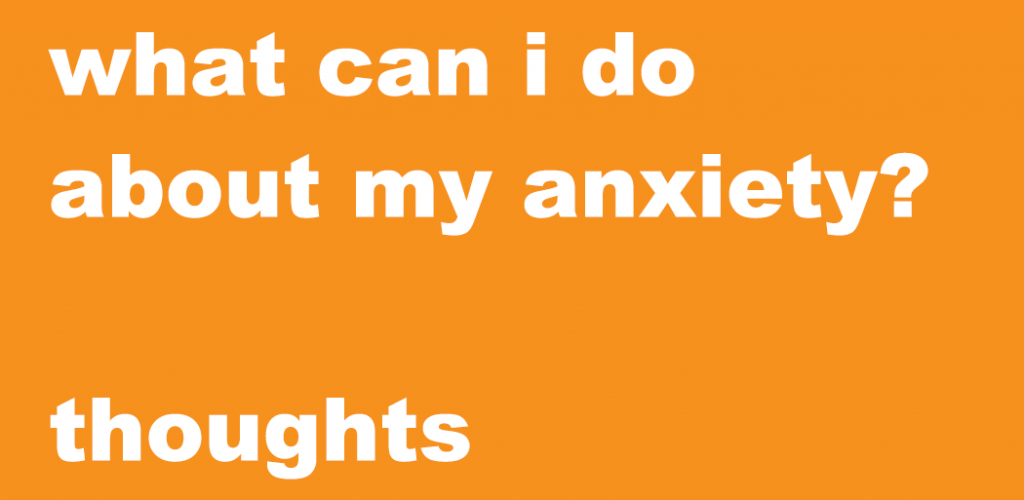What can I do about my anxiety? – Thoughts
Your emotions, physical body, thoughts and behaviours are all linked. What happens in one area usually impacts what is happening in another area. For example, if you are feeling overwhelmed by your school workload (emotion) you may become tense and jittery (physical state); you may think an anxious thought like “I am going to fail my class” (thought); and you may stay up all night studying (behaviour). This could create a cycle that causes more anxious emotions, thoughts, physical states and behaviours.
However, you can also use these links to decrease the overall impact of anxiety. For example, when you are feeling overwhelmed (emotion), you can practice deep breathing to lower your heart rate (physical state), which could allow you to think more clearly.
When it feels possible, you can practice managing and coping with your behaviours, emotions, thoughts and physical states to encourage more calmness. The more you practice, the easier it gets to cope and manage. Remember that you are not defined by your anxiety, or by your thoughts, feelings, behaviours, or physical states.
The following pages show some things you can do to cope with anxiety.
Thoughts
Anxiety can affect how you think and the kinds of thoughts you have. Feeling anxious might cause you to have thoughts that are unhelpful and unrealistic. It is good to notice whether this happens to you.
Journaling
Sometimes anxious thoughts can come from having too many thoughts in your mind that need time and space to be considered. Journaling can be a helpful exercise for sorting these thoughts out and giving them space.
10-minute stream of consciousness
- This can be done by writing or speaking and recording it on a phone or other device. Set a timer for 10 minutes. Write down or record yourself saying everything that comes to mind in a “stream of consciousness” style, where the goal is to not edit and to not stop writing or speaking at all, even if it doesn’t make sense. Stop after 10 minutes. Some people like to review what they wrote or said, while others do not. Some people choose to keep this record of their thoughts, while others may tear it up or discard it. Do what makes you feel best.
Scheduling “worry time”
- Set aside a short time every day when you give yourself permission to be anxious without trying to stop it. Write down or record your thoughts during this time. Make to-do lists if you like. Take no more than 15 minutes for this activity. You may find that you can spend less amount of your day worrying when you know that you have scheduled time to consider those thoughts later.
Talking
- Counselling and talk therapy are great ways to sort out your thoughts and get help with anxiety. A health professional can refer you to counselling resources, and counselling resources are also listed at the end of this booklet.
- You can also try talking with a supportive friend, family member, mentor, teacher, doctor, parent, or other trusted person in your life. It can feel intimidating to talk about anxiety with others. The following script can help guide your conversation on how to talk about anxiety:
- “Hey [person’s name], I have been feeling really [stressed/overwhelmed/nervous/any other emotion] about [topic/I don’t know why]. Could we take 10 minutes now or another time for you to listen to me as I talk about this?”
- Wait for them to tell you if it is ok for them right now so that the conversation feels comfortable and safer for both of you.
- Asking them to just listen to you can be a good way to get your thoughts and feelings out without interruption and without the other person feeling pressure to fix things or offer advice. However keep in mind that the other person may do these things anyway.
- As you learn what helps you with your anxiety, in addition to asking to talk about your experiences, you can also ask trusted people in your life to offer physical or emotional support in specific ways. For example, you might ask for a friend to hold your hand, to make you a cup of tea, to go for a walk with you, to distract you, or to remind you of how amazing you are.
Affirmations
Balancing out anxious thoughts with calming, positive and affirming thoughts can help reduce the impact of frequent anxious thoughts. Your affirming thoughts should feel meaningful, realistic, and true to you. Spending time writing and repeating your affirmations can help bring calming, positive thoughts into your mind more frequently.
At Planned Parenthood Toronto, a group of youth created a deck of affirmations for the Filling in the Blanks: Queering Sex Ed Project. Check out Resource: Affirmations Deck on our blog to download your own copy. You can pick up a printed affirmations deck from PPT if you live in Toronto.
Examples of affirmations:
- I am enough
- I am strong
- I am capable
- Let go
- I am in the right place
- I trust my intuition
- I feel my power
- I give myself time and space
- My feelings are valid
- I am kind to myself
- I am gentle with myself
Meditate with your affirmations
- Pick a quiet, comfortable place to sit or lie down and practice a few slow, deep breaths.
- Once you are settled, repeat your affirmation in your head to the pace of your breath. For example, for the affirmation “I give myself time and space”, as you inhale, say to yourself: “I give myself”, as you exhale: “time and space”.
- Practice this for anywhere from 5 to 15 minutes.
| Note on Techniques |
| These are just a few techniques that you can try out on your own. Just because one technique works for you, doesn’t mean that all of them will. Take what works for you, and leave the rest. |
This series contains things you can do that might help you to cope with and manage anxiety. Other pages in this series include:
- What is anxiety?
- What can I do about my anxiety? – Physical State
- What can I do about my anxiety? – Behaviour
- Resources for managing anxiety
If you have questions about this topic, feel free to contact one of our peer educators. [Link]
Last Edited: March 2020







